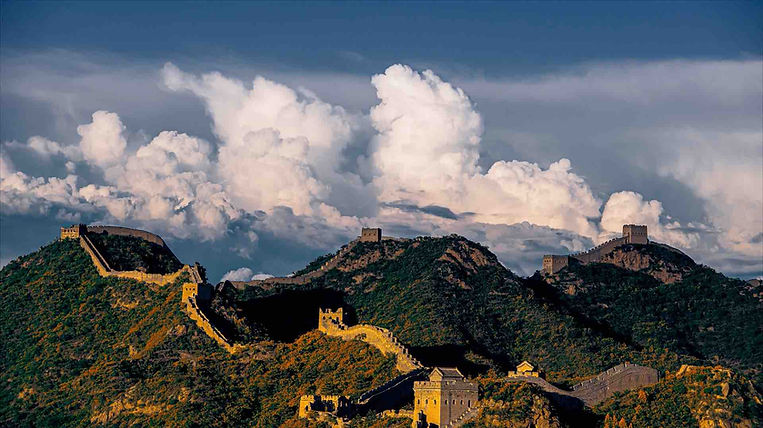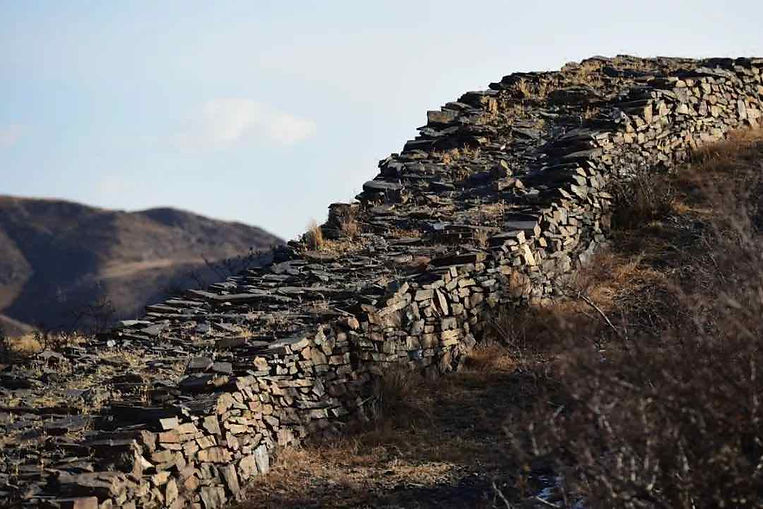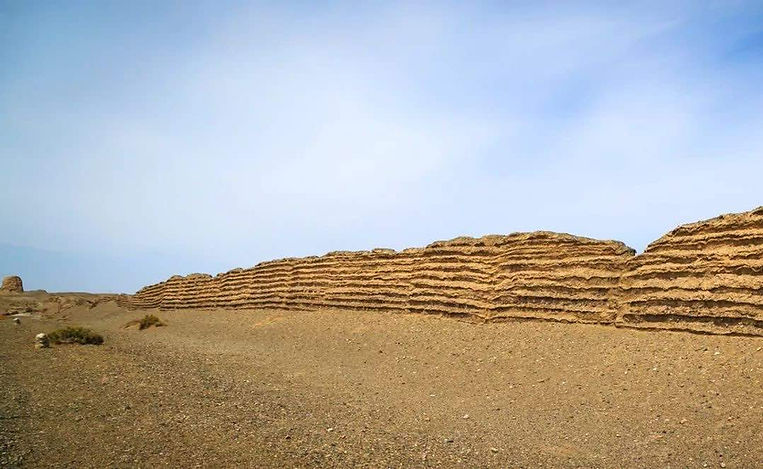The Great Wall of China — Historic Military Defense System and Significant Cultural Icon
The Great Wall of China, also known as Wan Li Chang Cheng, was an extraordinary military defensive system that protected the Middle Kingdom from northern nomadic invaders.
It served as a carrier and witness of history and remains an important symbol of Chinese culture.

The Great Wall of China, Photo from Official Site of Jinshanling.
Why Was the Great Wall of China Built?
How Did Genghis Khan and Manchu Conquer the Great Wall's Defense System?
How Did the Great Wall Serve Its Functions in History?
Who and When Built the Great Wall?
Where is the Great Wall of China?
Important Data and Some Fun Facts about the Great Wall
How Did the Beacon Tower System Work?

Why Was the Great Wall of China Built?
From the Western Zhou Dynasty (1046 BC — 771 BC), agricultural societies had formed, stabilized, and kept progressing, and their conflicts against nomadic groups became intense.
Peasants would reap what they sow, build houses, live stable lives with their families, and dedicate themselves to caring for and protecting their land.
Nomadic herders would keep migrating to places with sufficient water and grass to feed their livestock and were quite vulnerable to natural disasters, especially in winter.
Therefore, when nomadic in northern China lacked food and resources, they would ride their horses southward and rob peasants.
Sometimes, a few hundred cavalry warriors would cause considerable losses to farmers.

Unearthed Eggs and Pottery Jar of the Western Zhou Dynasty — Nanjing Museum (Photo by Dongmaiying)
To protect themselves, an alert system was built in the Western Zhou Dynasty.
The Western Zhou Dynasty constructed a series of castles on borders to defend against nomadic groups such as Yanyun and Quanrong.
Soldiers guarding those castles would ignite beacon fires to alert or command nearby armies and people when seeing invaders.
Then, people connected beacon towers and built long walls to defend themselves, but on smaller scales.

Centuries later, Qin Shi Huang united the Middle Kingdom and established the unified Qin Dynasty (221 BC — 207 BC).
He sent tens of thousands of laborers to construct the first version of the Great Wall of China to defend against the Xiongnu.
Afterward, the Great Wall was strengthened, expanded, and rebuilt several times, but its primary purpose remained consistent: to protect the agricultural Middle Kingdom from northern nomadic invasions.

Ruins of the Qin Great Wall in City Guyang, Photo by Huang Xiang.
Was the Great Wall Effective?
Constructing such a feat cost significant money and resources, and the empires that invested heavily in building it ultimately met their end. There's no doubt.
However, the culture of the agricultural Middle Kingdom, which the Great Wall was built to protect, has survived, been well-preserved, and inherited.
Language, characters, etiquette, tradition, history, customs, calendar, and more are all integral parts of the enduring Chinese culture.

Brocade Arm Guard of the Han Dynasty (202 BC — 220 AD) Embroidered Auspicious Words "Five Stars Rise in the East and Benefit China" — Xinjiang Museum (Photo by Dongmaiying)
It is easy to document how many times the Great Wall was breached and the lives that were lost during its construction.
However, it is quite tricky to determine how many times this magnificent defense system successfully repelled invasions from the north or how many lives were saved throughout history.
Meanwhile, historical documents suggest that constructing and garrisoning the Great Wall was much more cost-effective than implementing a northern expedition.

How Did Genghis Khan and Manchu Conquer the Great Wall's Defense System?
In history, the regimes of the Middle Kingdom, which the Great Wall was built to protect, failed and were replaced by nomadic regimes twice: first, the Mongolian Yuan Dynasty (1271 — 1368) replaced the Song Dynasty (960 — 1279), and later, the Manchu Qing Dynasty (1636 — 1912) replaced the Ming Dynasty (1368 — 1644).
However, from a technical standpoint, neither of them actually conquered the Great Wall defense system.
When Genghis Khan (1162 — 1227) was expanding, the Jurchen Jin Dynasty (1115 — 1234) was located on the other side of the Great Wall.
Genghis Khan defeated Jurchen Jin's troops several times, causing significant losses.
However, the Jin Dynasty finally perished due to the allied armies of his third son, Wokuotai Khan, and the Song Dynasty in the south.

Exquisite Jade Pedants of the Jurchen Jin Dynasty — Capital Museum of China (Photo by Dongmaiying)
When Kublai Khan established the Yuan Dynasty in 1271 and eradicated the Song Dynasty in 1279, the Song Dynasty only occupied the southern part of China and had no Great Wall to defend at all.
As for the Manchu, an important gate of the Great Wall (Shanhai Pass) was opened from the inside by General Wu Sangui after the Ming Dynasty ended due to rebellions in 1644.
The Great Wall has been a strong, magnificent system; things that determine the success or failure of an empire always revolve around people, humanity, or historical laws.

Shanhai Pass of the Great Wall, the Significant Gate that Wu Sangui Opened and Let the Manchu Army in.
How Did the Great Wall Serve Its Functions In History?
-
The beacon system could send information instantly and accurately.
-
The tall walls could force nomadic cavalry to dismount, reducing their speed and mobility.
-
It provided soldiers garrisoning nearby with valuable time to organize and prepare to fight back.
-
The Great Wall served as an excellent highway to transport soldiers and resources, especially when compared to steep paths on magnificent mountains.

The Flat and Wide Floor of the Great Wall Along the Magnificent Mountains
-
Even if a part of the Wall was breached, the invaders needed to quickly finish their robbery and retreat before the breach point was repaired.
Otherwise, they would find themselves in a desperate situation, completely cut off with no resources or reinforcements.
-
The Great Wall effectively controlled border trades, which the Middle Kingdom sometimes used as a means to sanction or block the nomadic regime's economy.
It also helped prevent smuggling and the leaking of important information.
-
The Great Wall and its nearby garrison towns had been used as perfect attack bases.

Yanmen Pass, An Important Fortreit on the Great Wall of China, Photo from Official Site of Yanmenguan.
Who and When Built the Great Wall?
Throughout history, emperors from various dynasties undertook the construction and strengthening of the Great Wall of China.
However, some made particularly significant contributions.
During the 7th century BC, State Chu and State Qi constructed defensive walls.
Later, during the Warring States Period (403 BC — 221 BC), other kingdoms built walls to defend against each other and the nomadic Xiongnu in the north.

Sections of the Great Wall Built by State Chu, Photo by Gucheng.
After Qin Shi Huang defeated other kingdoms and unified the Middle Kingdom area, he ordered the construction of national highways while dismantling the walls that former empires had built to defend against each other.
In 214 BC, Qin Shi Huang commanded the construction of the Great Wall, connecting the walls that former kingdoms had built to defend against the Xiongnu.
The Qin Great Wall, primarily made of stone, stretched from the eastern seaside to the western Gobi and is believed to be over 5000 kilometers long.

Ruins of Qin Great Wall in Guyang, Photo by Dai Wei.
After Emperor Wu of Han extensively defeated the Xiongnu, opened up the Silk Road, and significantly expanded territory, he commanded the construction of a Great Wall north of the Qin's Wall.
The Han Great Wall, also known as the Outer Great Wall (or Wai Chang Cheng), holds the record as the longest Great Wall in history, spanning over 10,000 kilometers.
Constructed as a defensive system, the Han Great Wall served as various attack bases against the Xiongnu and provided solid protection for merchants on the Silk Road during the Han Dynasty (202 BC — 220 AD).

Ruins of Han Great Wall in Gansu, Photo by Gucheng.
Afterward, some empires, such as the Northern Wei Dynasty (386 — 534) and the Sui Dynasty (581 — 618), constructed the Walls to defend against nomadic regimes.
However, some empires, such as the Tang Dynasty (618 — 907) and the Yuan Dynasty (1271 — 1368), did not build such defenses because their vast territories faced no threats from the northern borders.
After Zhu Yuanzhang overthrew the Yuan's reign and established the Ming Dynasty (1368 — 1644), the empire continuously constructed and strengthened the Ming Great Wall, which is the one most visited by people today.

Ming Great Wall Section, Photo by Gucheng.
Where's the Great Wall of China?
Based on the long history and various constructing dynasties, the existing Great Wall of China today, including ruins and well-preserved ones, is located in 404 towns of 15 provinces, autonomous regions, and municipalities, which are:
Beijing, Tianjin, Hebei, Shanxi, Inner Mongolia, Liaoning, Jilin, Heilongjiang, Shandong, Henan, Shaanxi, Gansu, Qinghai, Ningxia, Xinjiang.

Ruins of Yangguan Pass in Gansu, Built in the Year 107 BC, Photo by Sun Zhicheng.
Important Data and Some Fun Facts About the Great Wall
From the Spring and Autumn Period (770 BC — 403 BC) to the Ming Dynasty (1368 — 1644), the total length of the Great Wall of China is 21196.18 kilometers, which includes;
-
10051 segments of walls;
-
29510 buildings;
-
2211 castle-fortresses;
(info from http://www.greatwallheritage.cn/CCMCMS/)
-
Among all the Great Walls of China, the one built in the Han Dynasty (202 BC — 220 AD) is the longest (over 10,000 kilometers), and the one built in the Ming Dynasty (1368 — 1644) is of the best quality.

Ming Great Wall Jinshanling Section
-
The Ming Great Wall, the one that people mostly visit today, is 8851.8 kilometers long, which starts from the Hushan of Liaoning Province and ends in Jiayuguan of Gansu Province.
-
The building materials were mainly stone, earth, and brick, according to local resources and technology.
-
The width and length of the Walls varied based on terrain, military importance, and time. The average height of the Ming Great Wall is 7.8 meters.
-
Besides walls, there are tens of thousands of fortresses, beacon towers, grand passes, and garrison towns on the Great Wall, which were used to stock military resources and to station big troops.

The Jiayuguan of Ming Great Wall in Gansu, Photo by Diqiulvke.
How Did the Beacon Tower System Work?
Beacon Towers, known as Feng Sui or Fenghuotai, were places to release colored smoke during the daytime and set fires at night.
They have served as an important military alert system since the Western Zhou Dynasty (1046 BC — 771 BC).
Over time, the alert system was enhanced by adding the sound of drums and gunfire.
Each Beacon Tower was garrisoned by a few soldiers. They followed regulations to set fire, release smoke, and produce gunfire sounds upon spotting enemies.
This process conveyed information about the number and marching direction of invaders, as well as other crucial details.

Beacon Towers on Ming Great Wall in Jinshanling Section in Hebei Province, Photo by Gucheng.
Beacon towers were usually 2.5 to 5 kilometers away from one another, and every three adjacent towers should be within sight of each other to ensure the speed and accuracy of information transmission.
As for burning materials, they also varied from time to time, usually consisting of different types of herbs and dung.

Unearthed Ju of the Han Dynasty (202 BC — 220 AD), the Regulated Material to Burn on Beacon Towers at Night As Alert Message — Dunhuang Museum (Photo by Dongmaiying)
What Does the Great Wall Symbolize in Chinese Culture?
The Great Wall is not a guarantee of military success, but it remains a significant cultural icon of China to this day.
As one of the most remarkable feats constructed by millions of people throughout thousands of years, it represents determination, intelligence, courage, and bravery in protecting families and homelands.
As a carrier of history, traces of countless intense battles can be found on walls, buildings, and passes of the Great Wall, while valuable artifacts of the consistent Chinese culture that the wall protected are displayed in different museums.

Lacquer Wooden Spoon of the Han Dynasty (202 BC — 220 AD) Unearthed from Yumen Pass of the Great Wall, Belonged to Soldiers Used to Garrison There — Dunhuang Museum (Photo by Dongmaiying)
You Might Also Like:
Cultural Symbol Across Time and Space — Yellow River or Huang He River
Longest River of China — Yangtze River or Chang Jiang River
Guarding Warriors of the Mausoleum of the First Qin Emperor — Terracotta Army
Ancient Trade Routes That Connected the East and West — Silk Road
Chinese Palaces — Architecture and Art of Imperial Feats
Imperial Sacrificial Building Complex of Ming and Qing — Temple of Heaven
The Largest Existing Imperial Palace and Witness of History — Forbidden City
Magnificent Buddhism Palace on Tibetan Plateau — Potala Palace
Chinese Gardens — Aesthetics, Philosophy, and Architecture in Nature
Imperial Garden with Picturesque Views — Summer Palace
Classical Southern Garden of Borrowed Sceneries — Lingering Garden
Artful Southern Style Classic Garden — Humble Administrator Garden
Royal Mountain Resort In Picturesque Natural Views — Chengde
Royal Stone Carving Museums on Cliff — Longmen Grottoes
Exceptional Buddhist Art Gallery on Silk Road — Mogao Grottoes
Localization and Secularization of Buddhist Cave Art — Yungang Grottoes
Cultural Meanings of Extraordinary Attractions in China
Chinese Architecture — Tradition, Characteristic and Style
Ancient Towns with Exceptional Values
Magnificent Landmarks and Their Epic Stories
Legend, History, and Culture of Chinese Lakes
